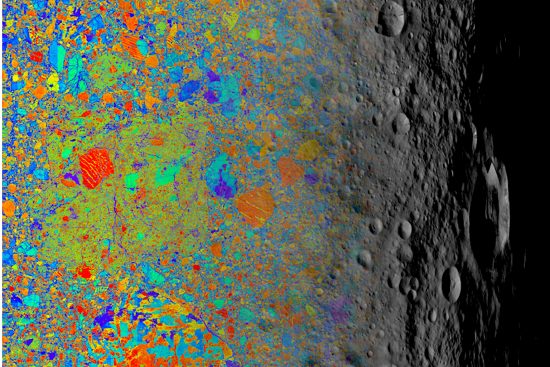
June 12, 2020
Vesta contains millions of micro-spherules.
“Great fleas have little fleas upon their backs to bite ’em,
And little fleas have lesser fleas, and so ad infinitum.
And the great fleas themselves, in turn, have greater fleas to go on;
While these again have greater still, and greater still, and so on.”
— Augustus De Morgan
On September 27, 2007 NASA launched the Dawn spacecraft on a voyage to the asteroid Vesta. Scientific observations began on July 17, 2011 and then came to an end on September 5, 2012. Dawn then fired-up its ion thruster engine and headed toward Ceres. Dawn entered the gravity field of Ceres at a distance of 61,000 kilometers at 7:39 AM EST on Friday, March 6, 2015 where it continues in orbit, and will remain for more than 50 years.
There are craters more than 50 kilometers in diameter on Vesta, even though it is a mere 564 kilometers by 531 kilometers. There is a particularly large crater near Vesta’s south pole that is 460 kilometers wide. As mentioned in previous Pictures of the Day, with such large impacts, it is remarkable that the asteroid was not blown to bits, particularly since the crater is about 13 kilometers deep, with an 18 kilometer high central peak.
According to a recent press release, data from the Dawn mission suggests that Vesta, rather than achieving its scarred condition in the initial protoplanetary nebula that gave rise to the Solar System, was hit by other asteroids and micro-meteors after it was already solidified.
A close examination of Vesta’s surface casts doubt on the notion that its large crater was created by an object smashing into it, especially since some of the smaller craters share walls that are thin and undisturbed by blast effects. Newtonian impacts should form dish-shaped holes with a blanket of blast debris surrounding the rims, sorted from largest to smallest particles. Vesta reveals a different kind of landscape. Its craters are clean and most are found in collections, as if a shotgun blast struck it.
In an Electric Universe, shallow craters with overlapping rims are important considerations in the theory of electrical effects. Planetary scientists ignore electrical explanations, which rectify the anomalies in other theories, because they know almost nothing about plasma and electric charge movement in space. Electricity can create the very things they are sending out probes to study. Theories that invoke meteor impacts, landslides and other familiar geological forces, ignore an electrically dynamic Solar System in its formative phases.
Electrical theory sees plasma discharges in the steeply carved cliffs on Vesta; features that are not easily explained by impacts. There are long canyons and furrows, some of which are ten kilometers wide, cut into the equator. A closer examination shows that those trenches (no matter what size) are chains of craters.
Asteroid formation does not require that one object smash into another one for there to be craters. Electric arcs can scoop out material, accelerate it into space, and leave behind deep pits. They tend not to disturb the surroundings, so they are used in industrial applications to finely machine metal parts. Based on laboratory analysis, that is what has occurred on Vesta: spark discharge erosion.
Stephen Smith
The Thunderbolts Picture of the Day is generously supported by the Mainwaring Archive Foundation.












